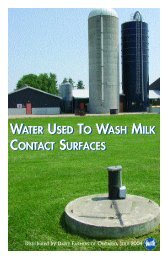Canadian Quality Milk On-Farm Food Safety Program - Centre ...
Canadian Quality Milk On-Farm Food Safety Program - Centre ...
Canadian Quality Milk On-Farm Food Safety Program - Centre ...
You also want an ePaper? Increase the reach of your titles
YUMPU automatically turns print PDFs into web optimized ePapers that Google loves.
<strong>Canadian</strong> <strong>Quality</strong> <strong>Milk</strong><br />
Construct floors, walls and ceilings of smooth, durable and easy-to-clean material,<br />
and maintain cleanliness on a regular basis.<br />
Properly ventilate the milk house to reduce condensation and decrease mould and<br />
dust on ceilings walls and windows.<br />
Properly dispose of any empty milking chemicals containers.<br />
7.3 MILKING EQUIPMENT EVALUATION AND<br />
MAINTENANCE<br />
<strong>Milk</strong>ing machines must be in good condition to obtain high milk quality consistently.<br />
Regular maintenance will assure that milking machines can milk cattle adequately day<br />
after day. Depending upon producer expertise, regular maintenance should be done by<br />
the producer with more in-depth analysis done by the equipment dealer or an industry<br />
professional.<br />
<strong>Milk</strong>ing machine technicians should be able to perform a complete evaluation protocol<br />
such as that produced by the National Mastitis Council (NMC).<br />
A milking equipment evaluation should include:<br />
• Teat end vacuum during milking.<br />
• Pulsation characteristics.<br />
• Effective reserve.<br />
• <strong>Milk</strong>line slope.<br />
This material on milking equipment was sourced from the manual “Managing <strong>Milk</strong><br />
<strong>Quality</strong>” published by ITA de La Pocatière.<br />
7.4 WATER<br />
<strong>Milk</strong> safety can be adversely affected by the quality of water used to<br />
clean milking equipment and the milk house. If the water is<br />
contaminated, the contaminants may cause milk safety to suffer.<br />
Since pasteurization does not kill 100% of bacteria in the milk,<br />
increasing the load of bacteria in the milk will increase the milk<br />
safety risk. Spore forming bacteria are usually found in dirty water.<br />
Spores can survive pasteurization and can reduce shelf-life of dairy<br />
products. The water used for cleaning milk contact surfaces can be<br />
a significant source of bacteria; therefore, testing the water is an<br />
important step in ensuring milk safety.<br />
June 2010 7—11
















